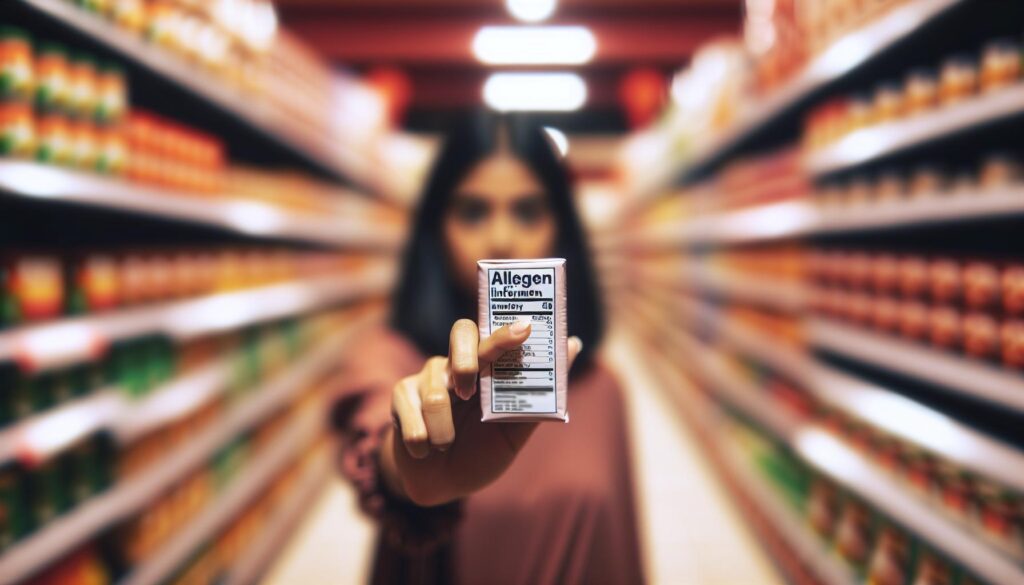How To Shop Safely With Peanut Allergies – Your Essential Guide
Navigating grocery stores can be tricky if you have a peanut allergy. With so many products and labels to sift through, it’s easy to feel overwhelmed. But don’t worry! This guide will help you shop safely and confidently, ensuring you find delicious options without the worry of allergens. Let’s dive in and make your shopping experience stress-free!
Table Of Contents
- Understanding Peanut Allergies
- Preparing for a Safe Shopping Experience
- Reading Food Labels Effectively
- Conclusion
- Related Posts
- Frequently Asked Questions (FAQs)
Key Takeaways
- Understanding peanut allergies is crucial for identifying safe food options and recognizing potential symptoms.
- Always read food labels carefully, looking for allergen warnings and ingredient lists to avoid accidental exposure.
- Research brands and products ahead of time to find safe alternatives that suit your dietary needs.
- Create a shopping checklist to streamline your grocery trips and ensure you don’t miss any safe products.
- Utilize tools and apps designed to help with label reading and allergen identification for a more efficient shopping experience.
Understanding Peanut Allergies

What Are Peanut Allergies?
Peanut allergies are one of the most common food allergies, affecting millions of people worldwide. They occur when your immune system mistakenly identifies peanut proteins as harmful, triggering an allergic reaction. Even a tiny amount of peanuts can cause a response, making it crucial to avoid them entirely. Peanut allergies can develop at any age, though they often appear in childhood and may persist for life.
If you’re unsure whether a product contains peanuts, tools like Home – Food Scan Genius can help. This AI-powered assistant scans product labels and identifies allergens, making shopping safer and easier. It’s a game-changer for anyone managing food allergies.
Symptoms and Risks of Peanut Allergies
Symptoms of peanut allergies can range from mild to severe. Mild reactions might include itching, hives, or a runny nose. However, severe reactions, such as anaphylaxis, can be life-threatening. Anaphylaxis may cause difficulty breathing, swelling, a drop in blood pressure, or even loss of consciousness. If you suspect an allergic reaction, seek medical attention immediately.
To minimize risks, always read food labels carefully. Look for terms like “may contain peanuts” or “processed in a facility with peanuts.” The FDA’s Food Allergen Labeling and Consumer Protection Act (FALCPA) requires manufacturers to clearly label major allergens, including peanuts.
For added peace of mind, consider using tools like Food Scan Genius. It simplifies the process by scanning barcodes and flagging potential allergens, helping you shop with confidence.
Preparing for a Safe Shopping Experience

Researching Brands and Products
Before heading to the store, take some time to research brands and products that are safe for those with peanut allergies. Many companies now offer allergen-free product lines, and knowing which brands to trust can save you time and stress. Start by visiting brand websites or checking allergen-friendly databases like Food Scan Genius. This tool allows you to scan product barcodes and instantly identify potential allergens, making it a must-have for safe shopping.
Additionally, look for brands that specialize in allergen-free foods. Websites like Snack Safely provide detailed lists of peanut-free snacks and products. Bookmark these resources for quick access when planning your shopping trip.
Creating a Shopping Checklist
A well-prepared shopping checklist can make your trip to the store more efficient and less stressful. Start by listing the items you need, and note any specific brands or products you’ve researched as safe. Include categories like snacks, pantry staples, and fresh produce to ensure you don’t miss anything.
For added convenience, use apps like Food Scan Genius to create a digital checklist. This app not only helps you organize your shopping but also flags any items that may contain peanuts or other allergens. It’s a great way to stay organized and confident while shopping.
By researching ahead of time and creating a detailed checklist, you’ll be better prepared to navigate the grocery store safely and efficiently.
Reading Food Labels Effectively

Decoding Food Labels for Peanut Allergies
Reading food labels is a critical skill when managing peanut allergies. It might seem overwhelming at first, but with a little practice, you’ll become a pro at spotting potential allergens. Start by looking for the “Contains” statement, which is required by the FDA to list major allergens like peanuts. For example, a label might say, “Contains: Peanuts.” This is your first red flag.
Next, check the ingredient list for hidden sources of peanuts. Ingredients like “peanut oil,” “groundnuts,” or “arachis oil” are all peanut derivatives. Be cautious of terms you don’t recognize—when in doubt, research them or avoid the product altogether.
Some labels also include a “May Contain” or “Processed in a Facility” statement. While these are voluntary, they indicate potential cross-contamination risks. If you see these warnings, it’s best to steer clear.
Tools to Simplify Label Reading
To make label reading easier, consider using tools like Food Scan Genius. This app scans product barcodes and flags any allergens, saving you time and reducing stress. It’s especially helpful for deciphering complex ingredient lists.
Another great resource is the Allergy Eats website, which provides user reviews of allergen-friendly products and restaurants. Combining these tools with your label-reading skills ensures a safer shopping experience.
By staying vigilant and using the right resources, you can confidently navigate food labels and make informed choices for your peanut-free lifestyle.
Conclusion
Shopping with a peanut allergy doesn’t have to feel like navigating a minefield. By understanding your allergy, preparing ahead of time, and mastering the art of reading food labels, you can confidently fill your cart with safe and delicious options. Remember, knowledge is your best ally—knowing what to look for and how to avoid potential risks is key to a stress-free shopping experience.
One of the most important takeaways is to always double-check product labels and stay informed about cross-contamination risks. Creating a shopping checklist and researching allergy-friendly brands can save you time and worry. And don’t forget, there are tools out there to make this process even easier.
Speaking of tools, if you’re looking for a way to simplify your shopping experience, Home – Food Scan Genius is a game-changer. This AI-powered assistant is designed specifically for people with food allergies and dietary restrictions. By scanning product barcodes, it helps you quickly identify safe options, saving you time and giving you peace of mind. You can download the Food Scan Genius app today on Google Play or the Apple App Store and start shopping smarter.
Your health and safety are worth the extra effort, and with the right strategies and tools, you can enjoy a worry-free grocery trip. So go ahead—shop confidently, eat joyfully, and embrace the best version of yourself!
Related Posts
- Navigating Shellfish Allergies while Shopping: A Comprehensive Guide – Food Scan Genius
- Navigating Milk Allergies while you shop: A Comprehensive Guide – Food Scan Genius
- Shopping for Family Members with Allergies: Safe Guide – Food Scan Genius
- Food Scan Genius
Frequently Asked Questions (FAQs)
What should I do if I accidentally consume peanuts?
If you accidentally consume peanuts, it’s crucial to stay calm. If you have a prescribed epinephrine auto-injector (like an EpiPen), use it immediately. Call emergency services or have someone take you to the nearest hospital, especially if you experience symptoms like difficulty breathing, swelling, or hives. Always inform your doctor about the incident for further guidance.
How can I ensure that a product is peanut-free?
To ensure a product is peanut-free, always read the ingredient list carefully. Look for any mention of peanuts or peanut derivatives. Additionally, check for allergen statements that indicate whether the product was made in a facility that processes peanuts. When in doubt, contact the manufacturer directly or choose brands known for their allergy-friendly practices.
Are there any safe alternatives to peanut butter?
Yes! There are several safe alternatives to peanut butter, such as almond butter, sunflower seed butter, and soy nut butter. These options provide similar textures and flavors without the risk of peanuts. Always check the labels to ensure they are processed in peanut-free facilities to avoid cross-contamination.
How can I educate my family and friends about my peanut allergy?
Educating your family and friends about your peanut allergy is essential for your safety. Start by explaining what a peanut allergy is, the symptoms, and the importance of avoiding peanuts. Share resources, such as articles or videos, that highlight the seriousness of food allergies. Encourage them to ask questions and be open about their concerns.
What are some tips for dining out with a peanut allergy?
When dining out with a peanut allergy, always inform the restaurant staff about your allergy before ordering. Ask about their food preparation practices to ensure there is no cross-contamination. Opt for restaurants that have experience accommodating food allergies, and consider checking their menu online beforehand to identify safe options.






19 Comments
[…] Food Allergen Labeling and Consumer Protection Act (FALCPA) requires clear labeling of major allergens. Look for terms […]
[…] is key when shopping for food allergies. Make a detailed list of what you need and safe alternatives. Here are some […]
[…] safe alternatives is key when managing a milk allergy. Thankfully, there are plenty of options available. Look for plant-based milk like almond, […]
[…] about 1 in 5 children with a peanut allergy outgrows it. But for adults, these allergies are often lifelong. Always carry an epinephrine […]
[…] reactions can range from mild itching to life-threatening anaphylaxis. A peanut allergy, for example, can cause swelling, difficulty breathing, and even loss of consciousness. Being […]
[…] effects of our food choices. They are moving towards plant-based living. Let’s look at some vegan efforts in Europe and the United […]
[…] you searching for the fountain of youth? A vegan lifestyle might be the answer to a longer, healthier life. Studies show that plant-based diets can prevent […]
[…] grocery stores offer a wide variety of vegan products, from essentials to specialty […]
[…] labeling is a cornerstone of FDA regulations. The Food Allergen Labeling and Consumer Protection Act (FALCPA) requires products to list major allergens like soy, milk, and […]
[…] like the Food Allergen Labeling and Consumer Protection Act (FALCPA) ensure that major allergens are clearly listed. This helps […]
[…] groups like China Vegan Society and the European SGS V-Label are also helping. They offer more options for those looking […]
[…] the right gluten allergy detector can change how you shop. Not all scanners are the same. Knowing the key features helps you choose […]
[…] the right gluten allergy detector can change how you shop. Not all scanners are the same. Knowing the key features helps you choose […]
[…] your commitment, navigating the transition can seem daunting at first. Fear not! This section will guide you through the essential steps, equip you with strategies to overcome challenges, and highlight the importance of support […]
[…] The product is made in a place that also handles the allergen, raising cross-contamination risks. […]
[…] allergies can make everyday life a challenge. Millions of people face hidden dangers. Our mobile allergy checker keeps you safe and […]
[…] inspiring example is a youth-led fundraiser that provided allergy-friendly snacks for schools. Events like these not only educate but also bring people together. Families, schools, […]
[…] those with allergies, the app is a lifesaver. It finds allergens in food labels. This helps users stay safe and […]
[…] Options: Discover a world of vegan-friendly and allergen-free products that you may have previously overlooked or avoided due to uncertainty. Food Scan Genius opens up a […]